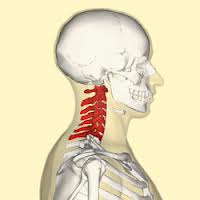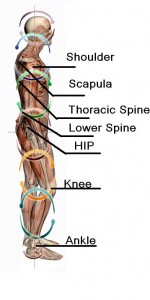How to Treat Limited Neck Motion – Headaches and/or Poor Athletic Performance
 What are common causes of neck pain?
What are common causes of neck pain?
With increase laptop use, long commutes and overall an increase in activities that require us to sit and a majority of time sitting in poor postures, tightness in our necks has become a common physical limitation. These limitations can affect anyone driving a car trying to look to change lanes, a tennis player hitting their shots, a golfer trying to get into a better backswing, a baseball player trying to see a pitch coming as the are batting, a football receiver or defense back trying to find the ball as they are running down the field, a basketball or lacrosse player trying to play better defense keeping track of the opposing players, etc.
What is interesting is that out of all 7 levels of the neck, half of your neck rotation occurs at one level. The motion in the joint between your first vertebrae (C1) and second vertebrae (C2) makes up about 45 degrees of the total rotation of your neck. This joint is commonly tight after traumas to the neck including whiplash injuries, falls and even with the stiff neck that you wake up with one morning that never goes away.
If the C1C2 joint is not moving, then the neck rotation motion has to come from either the skull on C1 or motion between C2-C7 which are not built to rotate more than about 45 degrees or half way. With the Greater (running more up the back of your head) and Lesser (more on the side of your head above you rear) Occipital Nerve coming off the C2 nerve root and running through the muscles at the base of your neck, these nerves become irritated producing many of the headaches that people associate to their neck tightness.
Many people, including athletes do not really understand how limited their neck motion is, especially when most people are able to compensate with other joint motion or movements. Unfortunately these compensations can lead to breakdown in other joints (C4, C5, C6, C7) and limitations in athletic skills leading to poor performance. Try the following test to see what your neck motion is:
How do I know what is causing my neck pain?
Test #1 – Sitting with your left shoulder towards a mirror. Turn your head to the left, keeping your chin level. People with limit neck rotation will bend their head backwards trying to gain more motion. Does your chin move over your left shoulder or at least over the far end of your collar bone? Now turn around and turn your head to the right, compare the amount of motion. It may help to have someone else note how much true rotation motion you have. Check to see if you are sitting in a good posture, if not correct your posture and repeat the test. You will notice more neck rotation while in a good posture.
Now perform Test #2 – Standing straight in front of a mirror with your hands placed on your chest, try to rotate your shoulders right and left without moving your head at all. (On a side note, your pelvis should not be moving either)
If you found that you have enough neck motion or mobility but that you could not able to move your shoulders without moving your head, you are having problems with stability or disassociation, which will be discussed in a future article.
A skilled physical therapist should be able to evaluate for a true neck mobility or stability dysfunction, treat and educate you on more specific exercises to maintain the required neck range of motion necessary to have full function in your neck thus reducing your headaches and/or enhancing your athletic performance.
For Help With Neck Pain or a Consultaion, Visit One of Our Clinics
Rancho Bernado Physical Therapy Clinic
Carlsbad Physical Therapy Clinic
Carmel Valley Physical Therapy Clinic
Mission Valley Physical Therapy Clinic


 Leg length differences in people can lead to abnormal sideways curves in the spine or scoliosis. Screening for scoliosis has been mandated to perform in the middle schools, girls in 7th grade and boys in 8th grade. Unfortunately, according to the Standards for Scoliosis Screening in California Public Schools 2007, a student is referred for a medical screening if the following results are found:
Leg length differences in people can lead to abnormal sideways curves in the spine or scoliosis. Screening for scoliosis has been mandated to perform in the middle schools, girls in 7th grade and boys in 8th grade. Unfortunately, according to the Standards for Scoliosis Screening in California Public Schools 2007, a student is referred for a medical screening if the following results are found: If you have a traumatic injury resulting from one occurance/accident or an over-use injury from multiple repetitions of the same motion, understanding the body’s Mobility-Stability model is crucial for a full recovery. Treating the area of pain may make you feel better, but it will probably not get you better.
If you have a traumatic injury resulting from one occurance/accident or an over-use injury from multiple repetitions of the same motion, understanding the body’s Mobility-Stability model is crucial for a full recovery. Treating the area of pain may make you feel better, but it will probably not get you better.